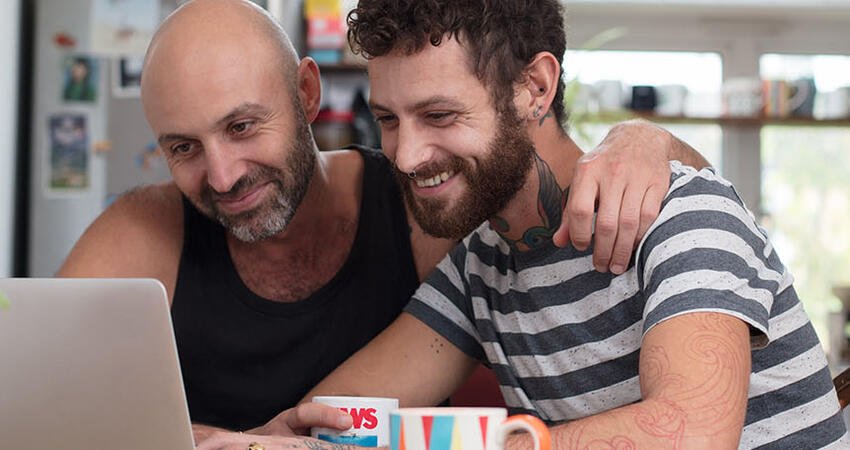
Five Facts about Housing Access for LGBT People
by Maya Brennan, Ally Livingston, and Veronica Gaitán
Our homes provide access to job markets, schools, health care, and economic opportunities. We build our lives on this foundation, yet, nationally, access to stable housing is less assured for lesbian, gay, bisexual, and transgender (LGBT) Americans. Starting in youth, rejection based on gender identity or sexual orientation contributes to higher rates of homelessness than among non-LGBT youth, destabilizing LGBT youth and adding vulnerabilities at a pivotal moment in the educational and employment trajectory. LGBT people might experience discrimination that restricts access to stable and decent housing, or they might limit their housing searches to states or localities with strong legal protections. These cracks in the foundation for LGBT people can impede economic well-being, mental and physical health, education, and more.
Here are a few things you should know to strengthen the housing foundation for LGBT people.
1. LGBT youth face more than twice the homelessness risk of heterosexual, cisgender youth.
A study conducted by Chapin Hall at the University of Chicago explored the scale and scope of unaccompanied youth homelessness nationwide through a nationally representative phone survey and follow-up interviews. For the segment of the survey administered to youth ages 18 to 25, researchers asked about couch surfing or homelessness over the prior 12 months, and the methods allowed a comparison of risks.
One in 10, or 3.5 million, youths ages 18 to 25 experienced homelessness over a 12-month period, but LGBT youth had a risk of homelessness 120 percent higher than heterosexual, cisgender youth. After controlling for other variables, such as race or ethnicity and high school completion, LGBT youth remained at more than twice the homelessness risk of non-LGBT youth. In the adjusted model, the only groups more at risk of homelessness than LGBT youth were those without a high school diploma or GED and unmarried youth with children.
Another study found that 40 percent of homeless youth are LGBT, and family rejection was a major factor for 68 percent of these cases.
2. Homeless service providers see more health problems in LGBT, genderqueer, and questioning (LGBTQ) youth.
The Williams Institute at the University of California, Los Angeles, School of Law surveyed homeless youth service providers to understand the experiences and service needs of LGBTQ homeless youth compared with other homeless youth. LGBTQ clients have worse mental health than non-LGBTQ clients, and trans clients are also in worse physical health. This aligns with other findings of disparities in physical health, public health risks, depression, and anxiety between homeless LGBTQ youth and other homeless youth.
Also, trans clients were more likely than LGBTQ clients to have experienced abuse, intimate partner violence, harassment, family rejection, and other traumas. But homeless lesbian, gay, and bisexual youth are more likely than heterosexual homeless youth to have histories of abuse or survival sex, according to prior research.
3. Twenty-one states and the District of Columbia have housing nondiscrimination laws that cover sexual orientation and gender identity.
States with laws that protect LGBT people from housing discrimination are mainly in the Northeast and Pacific regions. Some Midwest, Mountain, and mid-Atlantic states offer protection. Three southern states (Arkansas, North Carolina, and Tennessee) bar local antidiscrimination laws. Maps of states with an overall LGBT-supportive policy landscape show a similar geography of legal protections.
Forty-eight percent of LGBT people live in states that prohibit housing discrimination on the basis of sexual orientation and gender identity, somewhat more than the share of the US population in these states. Meanwhile, 2 percent of LGBT people live in states that prohibit housing discrimination based on only sexual orientation, and 50 percent of LGBT people live in states that do not prohibit housing discrimination on either basis.
Some states and the federal government have interpreted laws that prohibit sex discrimination as also prohibiting discrimination based on one’s “notion of how a person of a particular sex should act.” This interpretation could offer protection to some LGBT people but is not as clear-cut as being a protected class.
4. Gay men and transgender people experienced discrimination in rental housing searches, even in areas with antidiscrimination protections.
Using paired testing, Urban Institute researchers documented whether same-sex couples and transgender people experienced housing discrimination in searching for rental housing. Tests in the Dallas–Fort Worth and Los Angeles metropolitan areas focused on sexual orientation discrimination, while tests in the Washington, DC, metropolitan area focused on gender identity. At the time of the tests, state- or local-level protections existed in at least part of each of these areas.
Housing providers were less likely to make an appointment with gay male couples, told them about 1 fewer available rental unit for every 4.2 they mentioned to heterosexual men, and quoted higher rents. Transgender testers were told about fewer units than cisgender testers, and testers who stated their trans status were less likely to learn of available units. Differences in the treatment of lesbians and heterosexual women were small and not statistically significant.
Research has explored discrimination against same-sex couples responding to online rental ads. The study found that same-sex couples received fewer responses to email inquiries about available units. Interestingly, discrimination appeared to be higher in states with laws that prohibit discrimination on the basis of sexual orientation.
5. Through an emphasis on LGBT inclusion, service providers and housing developments can strengthen access to housing and services, especially for LGBT seniors and homeless youth.
LGBT-specific housing programs and services can offer targeted supports and a welcoming environment, even without restricting access by sexual orientation or gender identity. Such programs are especially common (and needed) for LGBT youth experiencing homelessness and for LGBT seniors seeking service-enriched housing. Mainstream housing and service providers can also improve their work through staff trainings to improve awareness and cultural competency. For senior-care providers, the nonprofit Services and Advocacy for GLBT Elders (SAGE) offers the SAGECare program with trainings on LGBT-inclusive communities and improving aging services for LGBT seniors.


